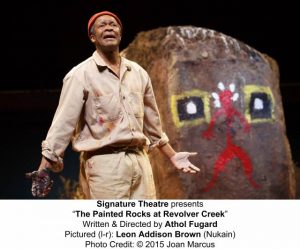
When the Signature Theatre commissioned a work from legendary South African playwright Athold Fugard, he retraced his steps back into an unfinished piece on Nukain Mabuza, a relatively unknown outsider artist, also South African, in order to create The Painted Rocks at Revolver Creek, a visually stunning and emotionally intimate portrait of life during and after apartheid.
Though Fugard fictionalizes elements of Mabuza's life, the physical and dramatic centerpiece of the play is Mabuza's art, the "garden" of rocks he painted for over two decades near the Afrikaner farm on which he worked. Fugard's tale begins in 1981, as Nukain embarks on the task of painting the biggest rock on the hill that is home to his garden. His other rocks are painted with vibrant patterns and colors -- "flowers," as he calls them -- but the aged Nukain knows that this rock will represent the culmination of his life's work, and must tell a special story. His young helper, whom he affectionately calls Bokkie, an Afrikaans pet-name meaning "small buck," watches in curiosity and admiration as Nukain faces his great challenge, using the rock and the paints available to him to tell the story of his life's journey. The life affirming, loving scene is destroyed as apartheid era politics come slinking in icily in the form of Elmarie, the Afrikaner farmer owner's wife. Act Two picks up two decades later, when a fully grown Bokkie, now Jonathan, a schoolteacher, returns to his old home with the hope of restoring Nukain's garden, and again finds himself confronting Elmarie.
 The set is a sparse, red earth, scattered with Nukain's flowers, that is capable of remarkable transition. In his interaction with Bokkie, Nukain's grounded earthiness and unflagging cheerfulness through song and art belies the harshness of the land, lending the elemental extremes an evocative, sensual quality. The old man belongs to the land because he treats it with respect and dignity and awe. He traversed its roads as a young man looking for work, and he worked the land all his life. In contrast, Elmarie, in her desire and perceived God given right to tame the land and impose an unnatural order upon it, evokes a hard, unforgiving stance. She derives power from fear, just as she demands Nukain whip Bokkie for his insolence after he cries out to defend Nukain's final rock painting. In turn, the land becomes frightening. In the new South Africa of Act Two, she is a broken, shivering woman, terrified of the invisible forces closing in around her to strip her of her land.
The set is a sparse, red earth, scattered with Nukain's flowers, that is capable of remarkable transition. In his interaction with Bokkie, Nukain's grounded earthiness and unflagging cheerfulness through song and art belies the harshness of the land, lending the elemental extremes an evocative, sensual quality. The old man belongs to the land because he treats it with respect and dignity and awe. He traversed its roads as a young man looking for work, and he worked the land all his life. In contrast, Elmarie, in her desire and perceived God given right to tame the land and impose an unnatural order upon it, evokes a hard, unforgiving stance. She derives power from fear, just as she demands Nukain whip Bokkie for his insolence after he cries out to defend Nukain's final rock painting. In turn, the land becomes frightening. In the new South Africa of Act Two, she is a broken, shivering woman, terrified of the invisible forces closing in around her to strip her of her land.
As Bokkie, 13 year old Caleb McLaughlin is moving without ever becoming overly precious. He's serious talented, more than capable of holding his own against his heavyweight cast mates, especially with racially challenging material. Leon Addison Brown is ferocious and heartbreaking as his voluntary guardian, desperate to assert his manhood in a political climate in which he is beaten down and given nothing to call his own. In Fugard's venerable tradition, the play is unabashedly political. Through his use of Afrikaans, Zulu, Xhosa, and other languages, the play is distinctly other, and yet the deeply troubling racial relations feel far too close to home. In the second act, Elmarie, played with pious, cold elegance by Bianca Amato and Jonathan, played with systematically restrained rage by Sahr Ngaujah, must try to understand each other. Without that, there is no hope for life or for growth, and there is no hope to rebuild the memory of the people who inhabited the lands, like Nukain.
Athold Fugard has referred to himself as an outsider artist. Though certainly not unknown, he has spent his life working to tell the story of the marginalized people of South Africa, trying expose the evils of apartheid to a larger audience, trying to make sense of his own place in his home nation. His legacy is unquestionable, yet, in his eighties now, his story bears stirring resemblances to Nukain's, looking back once more to reassert his humanity, to "paint the big rock."